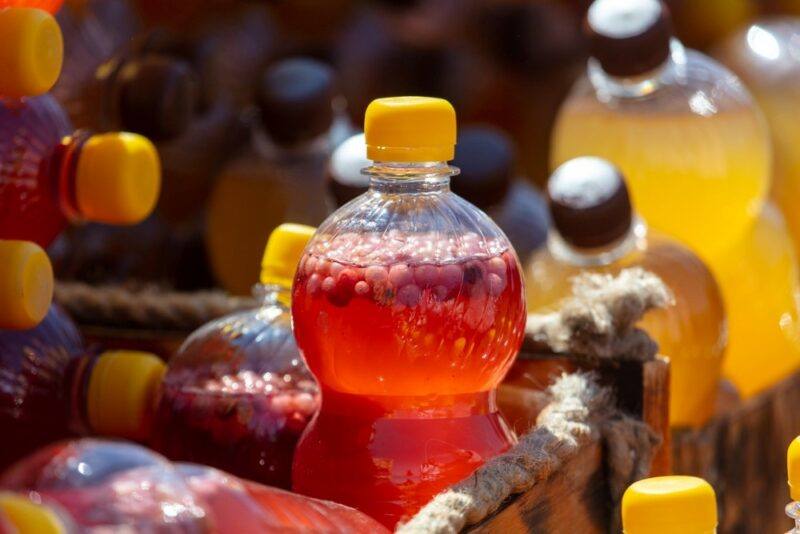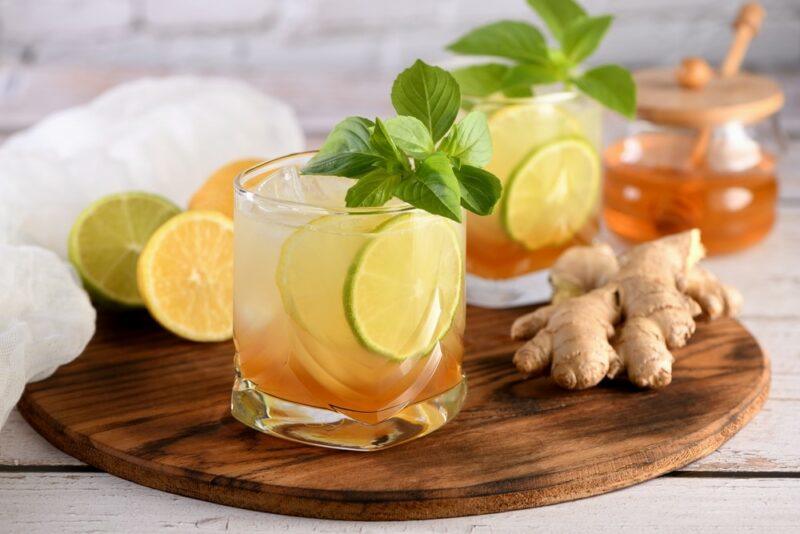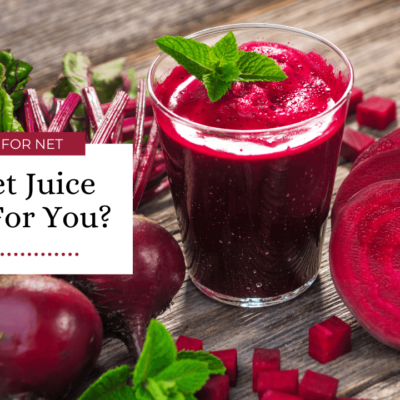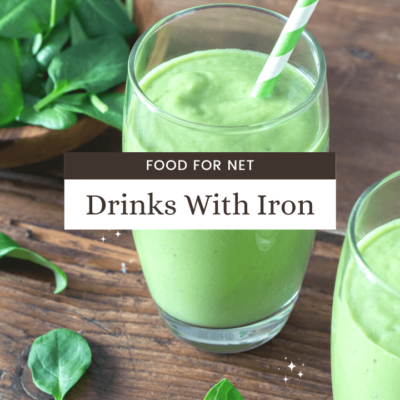
Have you heard of mead before? This traditional drink hasn’t been very popular in modern times, but is starting to take off – especially during Renaissance fairs and similar occasions. You may even see some mead being sold in local stores or perhaps you’re interested in how to make mead yourself.
If so, we have some fantastic news – making your own mead is generally legal. Doing so is considered homebrewing and falls under the same laws that govern homebrew beer and homemade wine (unlike making your own moonshine, which is an entirely different story).
We’ll take more about the laws surrounding mead a little later. For the moment, let’s take a closer look at the alcohol itself, including what it tastes like and how you can make it.
How To Make Mead
An Introduction To Mead

What Is Mead Made From?
Mead is much more than a drink from the past that features at Renaissance festivals. The drink itself has an extremely long history. It may even predate agriculture, although modern production methods aren’t always the same as traditional ones. These days it’s becoming increasingly cool and is often artisanally produced.
Mead often goes by the name honey wine, as the drink does use honey as one of the base ingredients. Specifically, it’s made by fermenting a mixture of honey and water.
This means that the term honey wine isn’t technically correct. After all, wine is a different type of alcohol entirely and is normally created using grapes. Plus, the term honey wine sometimes refers to regular wine with added honey.
Mead isn’t categorized as beer or cider. Instead, it’s an entirely distinct drink.
What Does Mead Taste Like?
Not surprisingly, mead tends to be sweet, with a honey-like flavor. There is also a touch of spice, which helps to round out the flavor profile.
That said, the flavor of mead is strongly influenced by the type of honey used. This can vary dramatically, which leads to some very distinctive mead expressions.
Some companies also add extra ingredients into their mead to change the flavor profile. For example, Noble offers a Mead with Blueberry as part of their monthly Cider & Mead Club. Their meads are often limited release, suggesting they should offer some very interesting flavors.
Companies also experiment with the amount of sweetness. Mead can be exceptionally sweet (and often is), but there are drier versions as well.
What Is The Alcohol Content?
Mead often comes in at around 14% to 20% ABV, which is similar to wine. However, this is an area that mead producers can easily play around with.
Some companies are intentionally producing much lighter meads, ones that are also fairly dry. These can be fantastic if you find that sweet and potent mead isn’t your style.
The Ingredients In Mead
At its most basic, mead relies on honey, water, and yeast. However, you can also add other ingredients, including spices, herbs, or fruit. Grain mashes are occasionally used as well.
These extra ingredients aren’t essential at all, but do help to create a more complex and interesting flavor profile.
How To Make Mead Yourself

So, how do you make mead?
As with wine and beer production, there are plenty of individual steps, decisions, and complexities. We can’t possibly cover all of these in this article. Instead, we’ll introduce you to the basics, along with some excellent resources for more information.
Gather Your Ingredients And Equipment
First things first, you’ll need to collect all the recruitment and sanitize it. The key pieces are as follows:
- A stock pot (ideally stainless steel)
- Plastic fermenter
- Fermentation lock and stopper
- Racking cane and tubing
- Hydrometer
- Thermometer
- Glass carboy
As for ingredients, you’re mostly looking at honey and water, but you’ll need some yeast to get the fermentation going as well. You can also experiment with fruit, spices, herbs, and even hops. These all provide extra flavor and make your mead even more interesting.
Remember that the type of honey makes a huge difference here. In particular, richly flavored honey will lend strong flavors to the mead, while mead made using mild honey will have milder flavors.
Be sure to avoid low quality honey, as this lacks complexity and can create inferior mead.
Get Things Started
Next, you’ll want to add roughly a gallon of water to the pot and boil for 10 minutes or so. After this, you take it off the heat and add honey (you may also need to add an energizer or other ingredients, depending on the recipe you’re following). Everything gets stirred together and held at roughly 170°F for 10 minutes.
Once the temperature drops down to around 80°F you should be able to stir in the yeast.
Fermentation
After the yeast has been mixed in for around 5 minutes or so, it’s time to add the mixture to the fermenter. Make sure the air lock is attached correctly.
While fermentation starts within a day or two, you’ll need to leave your mead for longer than that. You’re often looking at around 3 weeks, before you’re able to rack the mead into a new container and leave it to sit for a month or so. Then repeat with a new container, this time leaving it to sit for a few months.
Is This The Only Way?
The short answer is – no!
Mead is as much of an art as it is a science. There are countless variations in technique and ingredients, with everyone finding their own path. Here are a few other resources to check out if you’re interested in trying your hand at mead:
- A Beginner’s Guide to Making Mead from Almost Off Grid. This detailed article provides plenty of images and instructions, along with links to extra resources.
- How to Brew Mead from Batch Mead. This article recommends using a mead kit from Amazon and also offers step by step information for making a gallon of mead at home.
- The NewBee’s Intro to Mead Basics from The Men of Mead. This article doesn’t provide many details about actually making mead, but is packed full of other useful information, including the history of mead, what some of the terms mean, and what tools you need to make it.
Video: Everything you Need to Make Your First Mead
Is Home Mead Production Legal?

Mead isn’t distilled, so it isn’t subject to the federal laws that prohibit you from making moonshine, whiskey, and other spirits at home. However, it is subject to state laws. This means you’ll need to abide by the specific laws in your state (and should find out what these are before you begin).
Of course, if you’re in another country, the laws may differ considerably. You should do your due diligence wherever you live, especially as laws sometimes change and can be confusing.
These laws generally mean that you can make homebrew mead, but you can’t sell it. You often can’t even exchange it for other goods or services. There is a federal limit of 200 gallons of homemade alcohol per household, although states can create more restrictive limits if they choose to.
Make sure you check these laws carefully, as they can vary considerably. There are also some unexpected ones in the mix, such as not being able to remove the alcohol from the location in which it was brewed in some states.
The site Homebrew Academy has an interesting list of homebrew laws in every state. This was last updated in 2021, making it one of the most comprehensive and up-to-date resources out there. While the site focuses on homebrew beer, the legal details should apply to mead as well.
Commercial Mead Production
Why Is Mead Hard To Find?
Mead is an appealing drink and demand for it continues to grow. Yet, mead is still hard to find in the grocery store. Many people haven’t tried it at all, which sometimes leads to the impression that mead isn’t all that good.
Yet, the supply issue with mead has nothing to do with the quality of the drink. The problem is mostly related to honey and bees instead.
As you’ve probably heard, bee populations are decreasing, an effect that is partly driven by habitat loss and human use of pesticides on crops. A decrease in bees leads to a decrease in honey, meaning that less honey is available for mead production. And, because there’s typically more demand for honey itself than for mead, it’s hard for mead producers to access the interesting varieties of honey that they want.
Still, demand for mead is growing and some companies are being very successful at mead production. This should mean that more mead starts to hit the market as time goes on.
Our Favorite Mead Companies
While mead is fairly uncommon, some companies do sell it regularly. Here are a few options that produce high quality and delicious mead.
After all, you’ll probably want to try mead a few times before going to the effort of making it yourself.
Noble
Noble is primarily a cider company. They produce cider in ‘Lest’ West Asheville and have a separate taproom in Downtown Asheville (home of many decent breweries as well).
Noble offers some truly unique bottled meads, including Melato Forest Mead, Mesquite Blossom Mead, Orange Blossom Mead, and Strawberry Cyser (Apple Strawberry Mead). They also have cans of Session Mead, which are flavored with clementine, black currant, or honey apricot.
They even have a monthly club that ships out mead regularly. Unfortunately, this is a mead AND cider club that gives you three bottles of cider and only one bottle of mead per quarter. Still, mead-based clubs are rare, so this one is certainly worth a try.
Brothers Drake Meadery
Brothers Drake Meadery consistently gets good reviews, particularly because their mead isn’t excessively sweet. They’re a high quality brand too, with an emphasis on local honey, fruit, and spices.
They include some interesting flavors and approaches too. For example, some of their expressions include Ginger Verve (with chamomile, lavender, ginger, and vanilla), Apple Pie, and even a PB&J mead.
There’s even a subscription club. This one focuses on just mead – shipping out three bottles of mead every quarter. You can find their mead in some local stores or order online, although some products are only available to subscription club members.
Nani Moon
Finally, we have Nani Moon. This is a Hawaiian company that uses extra ingredients to flavor their mead. For example, Buzz Squared is a smooth mead that includes coffee as an ingredient and has an ABV of 12%.
There’s also Ginger Spice and Pineapple Lime, which are both obvious from their names. These meads also come in at 12% and carry interesting flavor profiles that are well worth trying for yourself.
If you want something different, check out their Deviant Beehavior. This has a slightly higher ABV and is both spicy and semi-sweet. The flavor profile is truly unusual, especially as there is white pineapple and chili pepper in the mix.
Is Commercially Produced Mead Better Than Homebrew Mead?

Homebrewing uses most of the same equipment and processes as commercial mead production, giving you the ability to make high quality mead at home.
However, commercial mead is often more consistent, especially as the companies use temperature control during fermentation. This temperature control prevents the development of many unappealing flavors. Companies may also have access to some adjunct flavoring ingredients that are difficult to source as an individual.
Beyond this, companies need to submit formulas and obtain approval before they make and sell their mead. This makes it difficult for the companies to experiment too much, although it means that the final product should always taste good.
Still… homebrew mead does have advantages. The biggest is that you have complete control over the recipe and the flavor profile. This is exceptional if you want to use unusual ingredients.
Many people prefer homebrew mead anyway, as commercial mead is often very sweet. You can easily create dryer mead at home and tweak other aspects along the way.
Final Thoughts
Mead isn’t beer, wine, or cider. It’s an entirely different product that is growing in popularity.
It’s versatile too. You can make it strong or weak, sparkling or still, sweet or dry. With so much variation, making mead yourself just makes sense. How else can you be sure the drink will be exactly what you’re looking for?

















 What Is Rum Made From, And What Are The 9 Types Of Rum?
What Is Rum Made From, And What Are The 9 Types Of Rum?
Leave a Reply